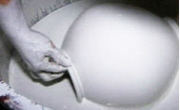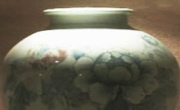From the late 17th to the early 18th century, Europeans were strongly intrigued by products from the East. Therefore, several countries like England, France, and Netherlands formed the 'East India Company' to pursue trade. First, European markets rapi...
http://chineseinput.net/에서 pinyin(병음)방식으로 중국어를 변환할 수 있습니다.
변환된 중국어를 복사하여 사용하시면 됩니다.
- 中文 을 입력하시려면 zhongwen을 입력하시고 space를누르시면됩니다.
- 北京 을 입력하시려면 beijing을 입력하시고 space를 누르시면 됩니다.
부가정보
다국어 초록 (Multilingual Abstract)
From the late 17th to the early 18th century, Europeans were strongly intrigued by products from the East. Therefore, several countries like England, France, and Netherlands formed the 'East India Company' to pursue trade. First, European markets rapidly responded to this desire for exoticism by importing goods; then, they produced imitation Oriental goods. Finally, they made stylistically advanced exotic merchandise from the perspectives of European. In terms of the textile industry, this trend was expressed in the pattern design of silk, or the so called ‘bizarre silk.’ In this paper, bizarre silk patterns were scrutinized based on a digital archive of museums, catalogues of museums, portal sites, and the literature. The bizarre silk patterns were analyzed then classified into six categories: pseudo-Oriental plant pattern, pattern mingled with architectural motifs, pattern of juxtaposed with Oriental goods, abstract pattern, exuberant pattern with metal threads, and semi-naturalistic pattern. These patterns were characterized according to the following features: strangely large exotic floral patterns were undulating and asymmetrical; exotic foliage and flowers were sometimes mixed with architectural motifs or Oriental goods to easily show the Oriental influence; motifs of bizarre silk patterns were abstractly stylized; bizarre silk patterns became luxurious once more like the Baroque period; finally, floral patterns became more natural, and still exotic motifs remained in the background to maintain the bizarre silk features. These bizarre silk patterns evolved from the viewpoints of Europeans through acceptance stage, compound stage, and confluent stage.
참고문헌 (Reference)
1 이은상, "중국 지식정보 유통과 시누아즈리 형성" 한국중국문화학회 (41) : 215-236, 2014
2 신상철, "미술 시장과 새로운 취향의 형성 관계: 18세기 로코코 미술에 나타난 쉬느와즈리(Chinoiserie) 양식" 한국미술사교육학회 25 : 155-180, 2011
3 김리나, "동서양의 만남과 미술의 교류" 미술사연구회 (23) : 7-28, 2009
4 Hayward, H., "World furniture: An illustrated history" Crescent Books 1990
5 The Holburne Museum, "The witcombe cabinet, English, japanned and silvered wood, about 1697 [Object Description 2006.4]"
6 "The witcombe cabinet, England, 1697"
7 Clarke, M., "The concise Oxford dictionary of art terms" Oxford University Press Inc 2001
8 Thornton, P., "The bizarre silks" 100 (100): 265-270, 1958
9 Riccardi-Cubitt, M, "The art of the cabinet: Including a chronological guide to styles" Thames and Hudson Ltd 1992
10 Rothstein, N., "The Victoria & Albert museum's textile collection: Woven textile design in Britain to 1750" Canopy Books 1994
1 이은상, "중국 지식정보 유통과 시누아즈리 형성" 한국중국문화학회 (41) : 215-236, 2014
2 신상철, "미술 시장과 새로운 취향의 형성 관계: 18세기 로코코 미술에 나타난 쉬느와즈리(Chinoiserie) 양식" 한국미술사교육학회 25 : 155-180, 2011
3 김리나, "동서양의 만남과 미술의 교류" 미술사연구회 (23) : 7-28, 2009
4 Hayward, H., "World furniture: An illustrated history" Crescent Books 1990
5 The Holburne Museum, "The witcombe cabinet, English, japanned and silvered wood, about 1697 [Object Description 2006.4]"
6 "The witcombe cabinet, England, 1697"
7 Clarke, M., "The concise Oxford dictionary of art terms" Oxford University Press Inc 2001
8 Thornton, P., "The bizarre silks" 100 (100): 265-270, 1958
9 Riccardi-Cubitt, M, "The art of the cabinet: Including a chronological guide to styles" Thames and Hudson Ltd 1992
10 Rothstein, N., "The Victoria & Albert museum's textile collection: Woven textile design in Britain to 1750" Canopy Books 1994
11 "Textile, silk, metallic yarns, late 17th - early 18th century"
12 "Textile, silk, metallic thread, late 17th - early 18th century"
13 "Textile, silk, late 17th-early 18th century"
14 "Textile, silk metallic thread, late 17th or early 18th century"
15 "Textile, Lyon,18th century"
16 "Textile, France, c.1705-1720"
17 "Textile, France, 1712-1724"
18 "Textile, 18th century"
19 "Textile, 1700-1710, French or Italian"
20 Battie, D., "Sotheby's concise encyclopedia of porcelain" Conran Octopus Limited 1995
21 "Silk Italy, early 18th century"
22 Ackermann, H. C., "Seidengewebe des 18. jahrhunderts I: Bizarre seiden [18th-century silks I: Bizarre silk]"
23 Kraatz, A., "Review of the books Seidengewebe des 18. jahrhunderts, 1: Bizarre seiden, by Hans Christoph Ackermann; Seidengewebe des 18. jahrhunderts: Die industrien in England und in Nordeuropa [18th-Century Silks: The Industries of England and Northern Europe], by Regula Schorta; La seta in Italia dal medioevo al seicento: Dal baco al drappo, by Luca Mola, Reinhold C. Mueller and Claudio Zanier]" 9 (9): 141-147, 2002
24 Davison, M., "Printed cotton textiles" 52 (52): 82-89, 1958
25 Emerson, J., "Porcelain stories from China to Europe" Seattle Art Museum & University of Washiongton Press 2000
26 Irwin, J., "Origins of the 'Oriental style' in English decorative art" 97 (97): 106-114, 1955
27 "Mounted teapot, porcelain about 1662-1690, mounts about 1700-1710"
28 The J. Paul Getty Museum, "Mounted teapot [Object Description 2001. 76]"
29 Porter, D. L., "Monstrous beauty: Eighteenth-century fashion and the aesthetics of the Chinese taste" 35 (35): 395-411, 2002
30 "Minneapolis Institute of Art. Panel from a Chasuble"
31 "Lacquer cabinet c.1680, Kyoto, Japan, and Paris, France"
32 "Italian fabric. c.1715"
33 Peck, A., "Interwoven globe: The worldwide textile trade, 1500-1800" The Metropolitan Museum of Art 2013
34 "Fragment, England, Spitalfields, c.1705-1706"
35 King, M., "European textiles in the Keir collection 400 BC to 1800 AD" Faber and Faber 1990
36 Lemire, B., "East & West: Textiles and fashion in early modern Europe" 41 (41): 887-916, 2008
37 "Dress fabric, Spitalfields, c. 1708"
38 "Dress fabric, Spitalfields, 1709, Artist/Maker: James Leman"
39 "Detail of the Cloak, Lampas, Venice 1705"
40 "Cope hood, late 17th or early 18th century"
41 "Chinese export for the European market, c. 1708-1710"
42 "Chalice veil date: 1690-1699(made)"
43 Slomann, V., "Bizarre designs in silks: Trade and traditions" Ejnar Munksgaard 1953
44 Irwin, J., "Bizarre designs in silks" 97 (97): 153-154, 1955
45 Slomann, V., "Bizarre designs in silks" 97 (97): 334-325, 1955
46 Thornton, P., "Baroque and rococo silks" New York, NY 1965
47 Wilson, K., "A history of textiles" Book Publishing Ye Gyeong 2002
48 Yoon, J.-I., "A consideration on influence of pottery development on Europen culture: Focusing on brands of the 18th century" 16 : 1-25, 2010
49 Harris, J., "5000 years of textiles" Smithsonian Books 2004
50 이은상, "18세기 전후 영국의 중국 인식" 한중인문학회 (42) : 181-203, 2014
동일학술지(권/호) 다른 논문
-
- 한국패션비즈니스학회
- 홍수진
- 2018
- KCI등재
-
케이트 미들턴의 로열 패션(Royal Fashion) 스타일 분석
- 한국패션비즈니스학회
- 이승희
- 2018
- KCI등재
-
- 한국패션비즈니스학회
- 김성달
- 2018
- KCI등재
-
- 한국패션비즈니스학회
- 이금희
- 2018
- KCI등재
분석정보
인용정보 인용지수 설명보기
학술지 이력
| 연월일 | 이력구분 | 이력상세 | 등재구분 |
|---|---|---|---|
| 2027 | 평가예정 | 재인증평가 신청대상 (재인증) | |
| 2021-01-01 | 평가 | 등재학술지 유지 (재인증) |  |
| 2018-01-01 | 평가 | 등재학술지 유지 (등재유지) |  |
| 2015-01-01 | 평가 | 등재학술지 유지 (등재유지) |  |
| 2011-01-01 | 평가 | 등재학술지 유지 (등재유지) |  |
| 2009-01-01 | 평가 | 등재학술지 유지 (등재유지) |  |
| 2006-01-01 | 평가 | 등재학술지 선정 (등재후보2차) |  |
| 2005-01-01 | 평가 | 등재후보 1차 PASS (등재후보1차) |  |
| 2003-01-01 | 평가 | 등재후보학술지 선정 (신규평가) |  |
학술지 인용정보
| 기준연도 | WOS-KCI 통합IF(2년) | KCIF(2년) | KCIF(3년) |
|---|---|---|---|
| 2016 | 0.36 | 0.36 | 0.43 |
| KCIF(4년) | KCIF(5년) | 중심성지수(3년) | 즉시성지수 |
| 0.5 | 0.56 | 0.669 | 0.14 |




 ScienceON
ScienceON KISS
KISS






